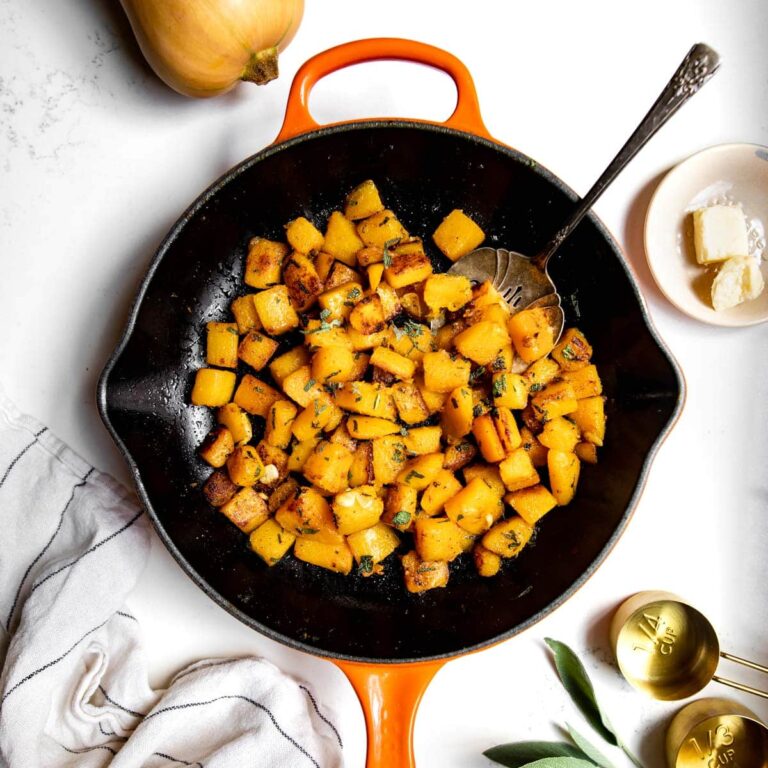[ad_1]
This Sautéed Butternut Squash is earthy, aromatic, and vibrant, perfect for any fall holiday. Infused with savory depth and aromatics like rich butter, garlic, and sage, this caramelized butternut squash side dish comes together quickly in one pan for the ultimate Thanksgiving side dish that’s sure to impress – watch out turkey!

Jump to:
Most often the main dish at holiday gatherings gets all the attention. But in our opinion, it’s the unique side dishes that truly reign. Whether it’s a cheesy green bean casserole, baked macaroni and cheese, or creamy red-skin mashed potatoes, the accompanying dishes are always the true holiday heroes.
This Sautéed Butternut Squash not only celebrates the season’s harvest but also highlights the comforting flavors and ingredients typically found on a Thanksgiving menu. It’s a one-pan side dish that’s a treasure of a veg when shared, with sweet, caramelized squash enhanced by rich butter, garlic and sage, each bite has a sensory contrast of crispy bits and creamy bites, making it a perfect side dish for autumn gatherings or a cozy weeknight dinner.
Why You’ll Love This Recipe
- It’s sensory: Sautéing brings out the natural sweetness of butternut squash, creating a caramelized flavor and a tender yet slightly crispy texture, that complements a Thanksgiving menu.
- It’s a crowd pleaser: A vegetable crowd pleaser? Trust us, this butternut squash side dish is so flavorful with subtle delicate notes that you’ll almost assume it’s the main part of the dish.
Serve this Sautéed Butternut Squash recipe alongside our Perfect Roast Chicken, One-Pot Chicken and Stuffing with Sausage, or our Thanksgiving Salad.
Ingredient List


- Butter: we always use salted butter. Butter adds depth and richness to the squash.
- Olive Oil: use extra virgin olive oil, the best quality available. The olive oil allows you to cook the squash without burning the butter.
- Butternut Squash: fresh butternut squash is best, but frozen will work too.
- Garlic: use fresh garlic. Look for firm cloves with minimal blemishes.
- Sage: the perfect herb pairing for butternut squash, fresh sage gives the dish an earthy and floral flavor.
See the recipe card for full information on ingredients and quantities.
Recipe Substitutions and Modifications
- Add cinnamon and spice: Butternut squash and cinnamon go great together. Add a light sprinkling of cinnamon while the squash sautees. Try this recipe spiced with pumpkin spice, cumin, chili flakes, or curry powder for a unique flavor.
- Make it sweet and savory: A drizzling of maple syrup, honey, or Hot Honey Sauce, a minute before the squash comes off the heat will make this recipe sweet and savory.
- Add vegetables: Sweet potatoes, parsnips, and carrots all have similar textures and cooking times as the butternut squash and make wonderful additions to the recipe to mix up the flavor and color of the dish.
Recipe Steps: How to Make Sautéed Butternut Squash


1. Saute the butternut squash.
Heat a skillet over medium heat and add butter and olive oil. Once the butter melts, add the squash and stir to coat it in the butter and oil. Sauté for 8-10 minutes, stirring occasionally, until the squash starts to soften and caramelize.


2. Flavor the squash.
Add the garlic and sage, and season with salt and pepper. Cook another 4-6 minutes, until the garlic is softened and the butternut squash is fork tender and lightly caramelized. Serve immediately.
Chef’s Tips for the Best Sautéed Squash
- Don’t use too much heat: Butternut squash cooks best on medium or medium-low heat. Cooking squash at high heat can burn the outside before the inside cooks through, leading to uneven texture. Lower heat ensures even, tender results.
- Mix oil and butter: Adding oil to butter raises the smoke point, preventing it from burning. This is ideal for cooking squash, which takes longer to soften than delicate vegetables.
- Don’t stir too much, or too hard: As the squash cooks, the outside will soften while the inside remains firm. Stir occasionally to allow caramelization, and gently to keep the squash intact.


Recipe FAQs
It’s usually best to peel butternut squash before cooking, as the skin can be difficult to chew. Peeling makes the flesh easier to cook and enhances the overall texture of your dish.
To avoid soggy squash, cook it over medium heat in a single layer to allow moisture to evaporate as it cooks. Avoid over-stirring to let the squash caramelize, and be sure to salt it towards the end of cooking to reduce water any release during sautéing.
Yes, squash can be sautéed with other vegetables. Just keep in mind the cooking times—firm vegetables like sweet potatoes or carrots can cook at the same time, while softer vegetables like onions or bell peppers should be added later.
To prevent sticking, heat your oil or butter before adding the squash. Use a well-seasoned cast iron pan, and avoid overcrowding the pan, which can cause the squash to steam instead of sauté.
Yes, you can sauté frozen squash, but it’s best to thaw and drain it first. Frozen squash can release excess water, so ensure the pan is hot to evaporate the moisture quickly, allowing the squash to brown and caramelize instead of becoming mushy.
Store leftover squash in an airtight container in the fridge for 4-5 days. Reheat the squash in the oven at 350°F for 8-10 minutes.
Craving More Unique Butternut Squash Recipes?
Did you make this Sautéed Butternut Squash? Please leave a ⭐️ star rating and let us know your thoughts in the 📝 comments below. And don’t forget to sign up for our email newsletter so you don’t miss any recipes. Thanks for cooking with us!
Recipe Card


Sautéed Butternut Squash
This Sautéed Butternut Squash is earthy, aromatic, and vibrant—perfect for any fall occasion. Cooked in rich butter, garlic, and sage, this savory dish is infused with deep flavors and enticing aromas. It’s a warm and comforting side dish that beautifully complements any meal, making it an ideal addition to your autumn table.
Servings: 4 servings
Instructions
-
Heat olive oil and butter in a large skillet over medium heat.
-
Once the butter is melted, add the squash and stir to coat it in the oil and butter. Saute for 15 minutes, stirring occasionally, until tender and golden brown. Season with salt and pepper, then sprinkle with sage. Gently toss the squash to distribute the sage.
-
Once the sage is fragrant, remove the squash from the heat and transfer to a dish for serving.
Recipe Notes
Lower the heat: Butternut squash cooks best on medium or medium-low heat. Cooking squash at high heat can burn the outside before the inside cooks through, leading to uneven texture. Lower heat ensures even, tender results.
Mix oil and butter: Adding oil to butter raises the smoke point, preventing it from burning. This is ideal for cooking squash, which takes longer to soften than delicate vegetables.
Don’t stir too much, or too hard: As the squash cooks, the outside will soften while the inside remains firm. Stir occasionally to allow caramelization, and gently to keep the squash intact.
Nutrition
Calories: 121kcal | Carbohydrates: 23g | Protein: 2g | Fat: 4g | Saturated Fat: 1g | Polyunsaturated Fat: 0.5g | Monounsaturated Fat: 3g | Cholesterol: 0.4mg | Sodium: 12mg | Potassium: 675mg | Fiber: 4g | Sugar: 4g | Vitamin A: 19938IU | Vitamin C: 40mg | Calcium: 106mg | Iron: 2mg
[ad_2]
Source link




0 Comments